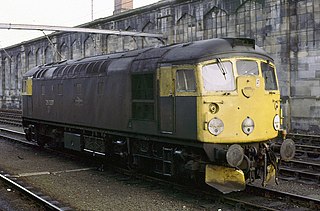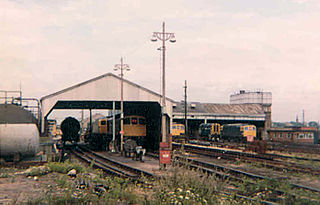Related Research Articles

The British Rail Class 03 locomotive was, together with the similar Class 04, one of British Railways' most successful 0-6-0 diesel-mechanical shunters. 230 were built at Doncaster and Swindon works between 1957 and 1962, and were numbered D2000-D2199 and D2370-D2399. D2370 and D2371 were used as departmental locomotives and originally numbered 91 and 92 respectively.

The British Rail Class 08 is a class of diesel-electric shunting locomotive built by British Railways (BR). As the standard BR general-purpose diesel shunter, the class became a familiar sight at major stations and freight yards. Since their introduction in 1952, however, the nature of rail traffic in Britain has changed considerably. Freight trains are now mostly fixed rakes of wagons, and passenger trains are mostly multiple units or have Driving Van Trailers, neither requiring the attention of a shunting locomotive. Consequently, a large proportion of the class has been withdrawn from mainline use and stored, scrapped, exported or sold to industrial or heritage railways.

The British Rail Class 89 is a prototype electric locomotive. Only one was built, in 1986, by British Rail Engineering Limited's Crewe Works. It was used on test-trains on both the West Coast and East Coast Main Lines. The locomotive was fitted with advanced power control systems and developed more than 6,000 bhp. After being withdrawn in 1992, it was returned to service in 1996, before being again withdrawn in 2000. As of January 2021, it is in the final stages of an overhaul that will return it to the main line.
British Rail reserved the TOPS Class 97 designation for departmental locomotives, which were used for special or engineering duties. They were therefore of several different classes, lumped together for numbering purposes. Some locomotives were converted from redundant engines, whilst others were purpose built. In 2008, Network Rail once again used Class 97 for signalling test locomotives.

The British Rail Class 31 diesel locomotives, also known as the Brush Type 2 and previously as Class 30, were built by Brush Traction from 1957-62. They were numbered in two series, D5500-D5699 and D5800-D5862. Construction of the first locomotive was completed in the final week of September 1957, and the handing-over took place on 31 October. The first Class 31 entered service in November 1957, after the launch of the Class 20 locomotive and was one of the Pilot Scheme locomotives ordered by British Railways to replace steam traction.

The British Rail Class 26 diesel locomotives, also known as the BRCW Type 2, were built by the Birmingham Railway Carriage and Wagon Company (BRCW) at Smethwick in 1958-59. Forty seven examples were built, and the last were withdrawn from service in 1994. Like their higher-powered sisters, the BRCW Classes 27 and 33, they had all-steel bodies and cab ends with fibreglass cab roofs. They were numbered D5300-D5346.

English Electric DP1, commonly known as Deltic, is a prototype 3,300 hp (2,500 kW) demonstrator locomotive employing two Napier Deltic engines, built by English Electric in 1955.

Loadhaul Ltd. was a railfreight operator based in the north-east of the United Kingdom. It was formed in 1994, as part of the privatisation of British Rail, and acquired in 1996 by a consortium headed by Wisconsin Central, then merged into a new company English Welsh & Scottish Railway. It is now part of DB Cargo.

The British Rail Class 37 is a diesel-electric locomotive. Also known as the English Electric Type 3, the class was ordered as part of the British Rail modernisation plan. They were numbered in two series, D6600–D6608 and D6700–D6999.

The British Rail Class 41 were two powercars built in 1972 by British Rail Engineering Limited's Crewe Works to operate with the prototype High Speed Train (HST) with Mark 3 carriages.

The British Rail Class 60 is a class of Co-Co heavy freight diesel-electric locomotives built by Brush Traction. They are nicknamed Tugs by rail enthusiasts.

The British Rail Class 20, otherwise known as an English Electric Type 1, is a class of diesel-electric locomotive. In total, 228 locomotives in the class were built by English Electric between 1957 and 1968, the large number being in part because of the failure of other early designs in the same power range to provide reliable locomotives.

The Class 59 3,300 bhp (2,460 kW) Co-Co diesel-electric locomotives were built between 1985 and 1995 by Electro-Motive Diesel for operation in Great Britain. A total of 15 locomotives were built for three different operators.

Immingham engine shed, also known as Immingham depot, or more recently as Immingham TMD and always locally as Loco is a railway maintenance depot located on the Immingham Dock estate, in North East Lincolnshire, England. The depot code is IM.

Hither Green (London) Traction Maintenance Depot or Hither Green (London) TMD is a railway depot used for the maintenance and servicing of freight trains adjacent to the Hither Green marshalling yard. The depot is a hub for moving freight around southeast England. Hither Green TMD is owned and operated by DBS. The official depot code is HG. In steam days the shed code was 73C.

The history of British Rail's corporate liveries is quite complex. Although from the mid-1960s to the 1980s the organisation was associated with "Rail Blue", a number of other schemes were also used, especially when it was split into operating units or "sectors" in the mid-1980s.
A builder's plate is usually a metal plate that is attached to rolling stock, bogies, construction equipment, trucks, automobiles, large household appliances, bridges, ships and more. It gives such information as the name of the manufacturer, the place and country of manufacture, the model number, the serial number, as well as the date of manufacture or date of fabrication of the item or unit.

Holbeck TMD is a traction maintenance depot located in Holbeck, Leeds, England. The depot is located on the west side of the line from Woodlesford, and is 57 chains (1.1 km) south of Leeds railway station.

Shirebrook TMD was a traction maintenance depot located in Shirebrook, Derbyshire, England. The depot was situated on the freight-only line between Pye Bridge Junction and Shirebrook Junction, which is now part of the Robin Hood Line. The depot was on the east side of the line, adjacent to the closed Shirebrook West station.

Ripple Lane TMD, BR depot code RL, was a traction maintenance depot located to the south of Castle Green, London, England. It was located 9 miles 7 chains (14.6 km) east of Fenchurch Street station near the marshalling yard between Dagenham Dock and Barking stations. The actual depot was situated between the running lines with the up line to the south of the depot and the down line to the north.
References
- ↑ "British Railways Publicity". Southern Railway Publicity. 20 May 2013. Retrieved 16 February 2015.
- ↑ "Promotion of the Rail Riders Club for children aged 5-15: includes proposals for future operation" (AN 185/85). AN 185 - British Railways Board: Passenger Marketing Services: Records. National Archives. 1 August 1981.
- ↑ Robin. "Knitting Pattern Child's DK Rail Riders Motif Sweater 24-34" To Knit Robin 13374". Amazon UK website. Retrieved 2 June 2015.
Knitting Pattern Leaflet Robin 13374: Instructions To Make Sweater With Rail Riders Motif. British Rail Logo and Hst [ sic ] Design Knitted From Chart
- ↑ "Going off the rails". The Independent. 29 June 1991. p. 44.
- ↑ "Rail Riders is returning after nearly 30 years". 7 October 2019.
- ↑ White, Jim (29 October 1990). "1,650 miles in one day? Easy-peasy". The Independent. p. 14.
- ↑ McLean, Bill (25 February 1988). "Medieval York offers the tourist a grand old time". Glasgow Herald. p. 23. Retrieved 2 June 2015.
Another poster enthused about "Britain's Best Model Railway at Rail Riders World in York Station,"
- ↑ Aitchison, Gavin (26 March 2008). "End of line for model railway?". The Press (York) . Retrieved 16 February 2015.
- ↑ "Model Railway heading to Lincolnshire after 27 years at York Station". Scunthorpe Telegraph. 10 January 2011. Archived from the original on 16 February 2015. Retrieved 16 February 2015.
York Model Railway is making tracks to Lincolnshire after 27 years in its current home. The tea rooms at York Station have been host to the exhibition since its inception … owner William Heron
- ↑ "Rocketing rent leads to relocation of museum". Lincolnshire Echo. 14 January 2011. Retrieved 15 February 2015.
Mr Heron reckons the Rail Riders World, Thomas The Tank Engine and Bavarian scene model railways, complementing a smaller n-gauge layout, will be open from the end of March.
- ↑ "New Tenant Sought for Prestigious Premises Following Departure of York Model Railway". Media Centre (Press release). East Coast (train operating company). 6 January 2011.
- ↑ Marsden, Colin J.; Ford, Darren. Encyclopaedia of Modern Traction Names (PDF). p. 198. Archived from the original on 23 October 2007.
{{cite book}}: CS1 maint: unfit URL (link) - 1 2 Appleby, Paul (2 October 2014). "47 406". Class 47 website. Retrieved 2 June 2015.
Newcastle Central station by David Atkins (aged 9), winner of a Rail Riders competition December 10th 1981 ~ A crest representing the Rail Riders club badge was added on November 12th 1985 to celebrate a 4-fold increase in Rail Riders club membership ~ Plates removed in May 1988.
- ↑ Appleby, Paul (2 October 2014). "47 488". Class 47 website. Retrieved 2 June 2015.
Crewe Diesel TMD without ceremony. August 9th 1988 ~ Name previously carried by 47 406. ~ Plates removed in August 1992.
- ↑ "Bachmann 31-650P Special Commission BR Class 47/4 "Rail Riders" Intercity" . Retrieved 16 February 2015.
31-650P … limited run of 512 pieces. This celebrity loco was named after BR’s Rail Riders club which was established to promote rail travel and safety to young people.